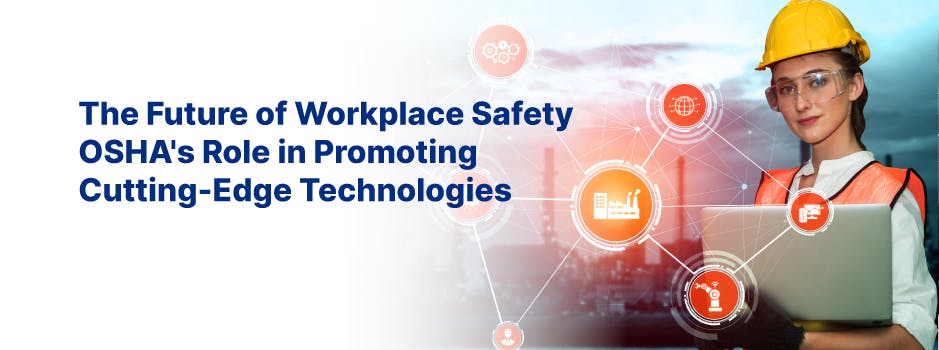Introduction
Workplace safety has come a long way over the years, thanks to advancements in technology and the dedication of organizations like the Occupational Safety and Health Administration (OSHA). As we look towards the future, OSHA continues to play a critical role in promoting cutting-edge technologies that will further enhance workplace safety. In this blog, we will discuss the role of OSHA in driving innovation and explore some of the emerging technologies that are revolutionizing the field of workplace safety.
OSHA's Commitment to Innovation
OSHA is committed to staying ahead of the curve when it comes to workplace safety advancements. They recognize that emerging technologies have the potential to significantly reduce workplace hazards, improve compliance, and make workplaces safer and more efficient. As a result, OSHA actively engages with industry leaders, researchers, and other stakeholders to identify, develop, and promote innovative safety solutions. This collaboration is essential for driving the adoption of new technologies and ensuring that safety standards evolve with the changing landscape.
Wearable Technology
Wearable technology has the potential to revolutionize workplace safety by providing real-time data on workers' physical conditions and environmental factors. Some examples of wearables in the workplace include:
- Smart helmets: Equipped with sensors to monitor temperature, humidity, and impact forces, these helmets can provide early warnings of potential hazards and help prevent heatstroke, exhaustion, or head injuries.
- Biometric wearables: Devices such as smartwatches and fitness trackers can monitor workers' vital signs, including heart rate, blood pressure, and body temperature, allowing employers to identify and address potential health concerns before they become critical.
- Exoskeletons: These wearable devices can assist with lifting heavy objects, reducing the risk of musculoskeletal injuries and improving overall productivity.
OSHA is actively involved in researching and promoting the use of wearables to enhance workplace safety, while also working to address potential privacy and security concerns related to their use.
Advanced Robotics and Automation
Robotics and automation are transforming the way work is done, often taking over dangerous or repetitive tasks that pose a significant risk to human workers. OSHA recognizes the potential of these technologies to improve safety and has been collaborating with industry stakeholders to develop guidelines and standards for their safe integration into the workplace. Some examples of robotics and automation in workplace safety include:
- Collaborative robots (cobots): Designed to work alongside human workers, cobots can assist with tasks that require precision, strength, or endurance, reducing the risk of injury and fatigue.
- Automated safety inspections: Drones and remote-controlled devices can be used to inspect hazardous or hard-to-reach areas, minimizing workers' exposure to potential hazards.
- Machine learning algorithms: Advanced algorithms can analyze workplace data to identify patterns and predict potential safety incidents, allowing employers to take proactive measures to prevent accidents.
Internet of Things (IoT) and Connected Workplaces
The Internet of Things (IoT) refers to the network of interconnected devices, sensors, and systems that collect and share data. In the context of workplace safety, IoT can provide valuable insights into the work environment, equipment performance, and worker behavior. OSHA is actively exploring the potential of IoT to enhance workplace safety and promote compliance. Some examples of IoT applications in workplace safety include:
- Environmental monitoring: IoT sensors can continuously monitor workplace conditions, such as air quality, temperature, and noise levels, alerting employers to potential hazards and enabling real-time corrective action.
- Equipment maintenance: IoT-enabled predictive maintenance systems can analyze equipment data to identify potential failures or malfunctions before they occur, reducing the risk of accidents and downtime.
- Worker tracking and communication: IoT devices can help track workers' locations, especially in hazardous or remote areas, and facilitate communication between workers and supervisors, ensuring that everyone is aware of potential hazards and emergency situations.
Virtual Reality (VR) and Augmented Reality (AR) Training
VR and AR technologies offer immersive and interactive training experiences that can significantly improve workplace safety. By simulating real-world scenarios, workers can practice navigating hazardous situations and learn proper procedures without exposing themselves to risk. OSHA recognizes the potential of these technologies and supports their integration into safety training programs. Some applications of VR and AR in workplace safety include:
- Hazard recognition training: Workers can use VR or AR to identify potential hazards in a simulated environment, helping them develop keen hazard recognition skills that can be applied in the actual workplace.
- Emergency response simulations: VR and AR can create realistic emergency scenarios, such as fires, chemical spills, or natural disasters, allowing workers to practice their response skills and improve their preparedness for real-life emergencies.
- Equipment operation training: Using VR or AR, employees can learn to operate complex machinery or equipment in a safe, virtual environment before handling the actual equipment.
Big Data and Predictive Analytics
The analysis of large datasets can provide valuable insights into workplace safety trends and help organizations identify areas for improvement. OSHA is actively exploring the potential of big data and predictive analytics to enhance workplace safety by:
- Analyzing injury and illness data: By examining historical data, organizations can identify patterns, pinpoint areas of concern, and develop targeted strategies to reduce workplace hazards.
- Evaluating the effectiveness of safety interventions: By monitoring the impact of safety initiatives, organizations can determine which strategies are most effective and make data-driven decisions to optimize their safety programs.
- Identifying leading indicators: By analyzing data on near-miss incidents, equipment maintenance, and worker behavior, organizations can identify leading indicators of potential safety incidents and take proactive measures to prevent accidents.
Conclusion
As technology continues to advance, OSHA remains committed to promoting cutting-edge solutions that improve workplace safety. By staying ahead of emerging trends and fostering collaboration between industry stakeholders, OSHA plays a crucial role in driving innovation and ensuring that safety standards keep pace with the rapidly evolving landscape. As we look to the future, the integration of technologies such as wearables, robotics, IoT, VR, and big data analytics will undoubtedly transform workplace safety, making it more efficient, effective, and accessible for everyone.

